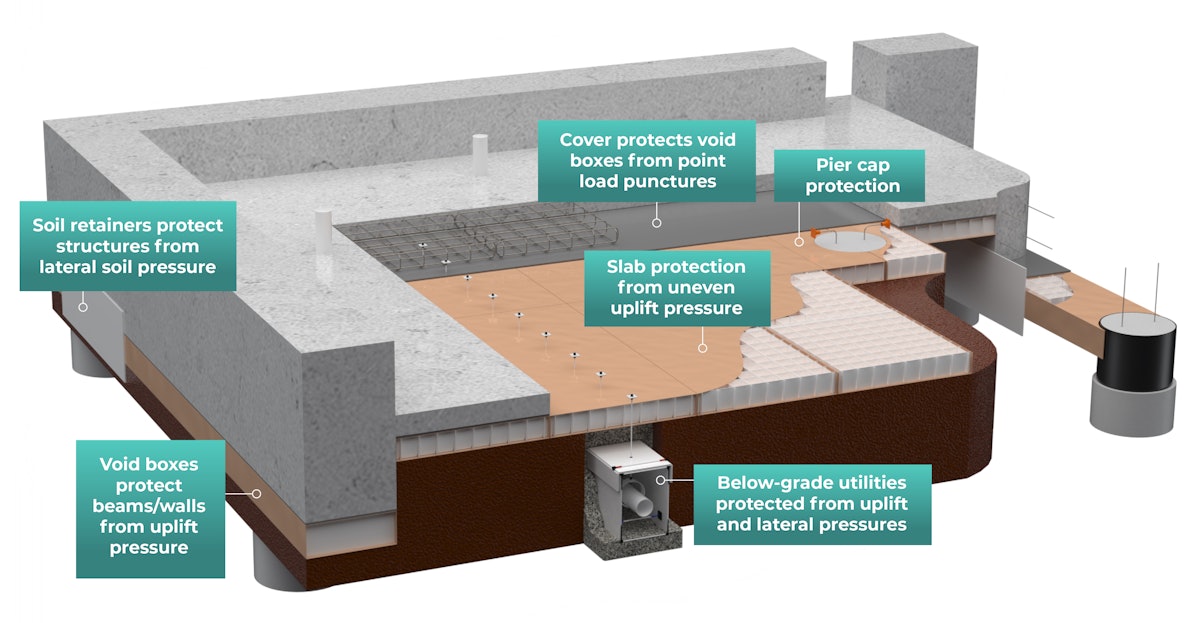It comes as no surprise to architects and engineers that clay-rich soils which retain lots of moisture are unstable. Clay soils have a water-holding capacity of about 1.35-2.5 in. of water per foot of soil, whereas well-drained sandy soils hold far less, typically 0.4-1.25 in. of water per foot of soil. This ensuing soil instability for clay will readily convey to foundations built on the expansive soils, and if those foundations are not properly engineered to accommodate heaving and movement, structural failure is all but guaranteed.
The American Society of Civil Engineers claims that expansive soils in the U.S. already cause an estimated $2.3 billion in annual damage to buildings and infrastructure. This easily approaches (and in some years surpasses) the yearly damage caused by natural disasters, such as earthquakes, floods, hurricanes, and tornadoes.
A review of any US soil map will show many areas in the U.S. have clay-rich soils, yet – due to low costs and rural locations – many of these same areas are prime locations for massive IT data centers and server farms that are being constructed, seemingly at break-neck speed, to be nerve centers for advanced IT and AI networks.
Although unstable soils are abundant in Mississippi, Louisiana and Arkansas, the state of Texas is a prime example of the risky mix of unstable soil and IT data centers. Vast swaths of Texas have potentially unstable soil that present shrink-swell cycles that challenge the best structural engineers to counter the ever-present problem. And the problem is sizeable indeed. These soils can move consistently and dramatically, exerting up to 30,000 pounds of pressure per square foot.
Across these states, engineers of large-scale infrastructure projects like data centers have looked to a range of solutions to mitigate the structural risks associated with expansive soils. The key is to create purpose-built void spaces beneath and around concrete beams, walls, slabs, and critical below-grade utilities.
With a long history of safe and effective use, void space systems – typically corrugated wax-coated fiberboard – can isolate the upward pressures caused by expansive, swelling soils, redirecting the force into designated voids. This approach can help ensure long-term structural integrity for concrete/foundation elements of a structure.
Void space systems are not new, and they have been used on hundreds of millions of square feet of concrete structure. Search “products that create void spaces in concrete foundation and slab design” to see a range of solutions.
Why Are Voids More Important Now?
The U.S. is at the forefront of the global data center expansion, with over 3,000 data centers currently in operation nationwide. Once considered a niche infrastructure sector, data centers are now receiving significant national attention and major investments, making headlines across the country. Recently, the industry gained even greater front-page prominence with President Donald Trump’s announcement of The Stargate Project. This $500 billion initiative includes a major new data center in Texas.
Adding to the concerns of unstable soils, this explosion in data center development has expanded well beyond traditional tech hubs and metropolitan areas, with a growing network reaching into more affordable rural regions where land and electricity are more affordable and where clay-rich soils may be abundant. The Stargate Project is undeniably the most notable recent development in data centers. Set to launch in Abilene, Texas, the project has already begun construction on 10 structures. According to a White House press conference, OpenAI was “evaluating potential sites across the country for more campuses.”
The Stargate Project is just one example where soil quality will affect IT build-outs. Looking at recent news in the second half of 2024, several large-scale data center projects were also announced, adding millions of square feet to this rapidly expanding Texas tech sector:
- In August, Google announced a billion-dollar investment in the North Texas Google Cloud Region.
- Shortly after, in September, DataBank announced a new development in Red Oak, Texas, that, once complete, will sprawl across 292 acres with a 480-megawatt facility.
- In December, Lincoln Property Company released details of their four-building, 800,000 sq. ft. data center located on the outskirts of Dallas, set to start in the beginning of 2025.
- Also in December, Colovore launched the $500m Project Raptor in Williamson County, with construction expected in 2026.
No matter how “new and shiny” these IT data centers are, we are in a time when high-tech meets low-tech, and structural engineers will be a key part of any data center planning. The importance of unstable soil accommodation will be central to data center planning, and void space management will be central to these efforts.
PULLQUOTE
The key to structural stability is to create purpose-built void spaces beneath and around concrete beams, walls, slabs, and critical below-grade utilities.
View the original article and our Inspiration here


Leave a Reply